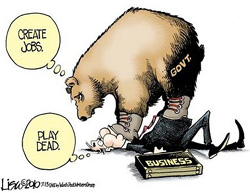 by Tom McClintock –
by Tom McClintock –
The government’s continuing failure to address our nation’s gut-wrenching unemployment stems from a fundamental disagreement over how jobs are created in the first place.
We are now in the third year of policies predicated on the assumption that government spending creates jobs.
We have squandered three years and trillions of dollars of the nation’s wealth on such policies, and they have not worked because they cannot work.
Government cannot inject a single dollar into the economy until it has first taken that same dollar out of the economy.
True, we can see the job that is saved or created when the government puts that dollar back into the economy. What we can’t see as clearly are the jobs that are destroyed or prevented from forming because government has first taken that dollar out of the economy. We see those millions of lost jobs in a chronic unemployment rate and a stagnating economy.
Government can transfer jobs from the productive sector to the government sector by taking money from one and giving it to the other. That’s at the heart of the president’s plan to spend billions of dollars to hire more teachers and firefighters and police officers. But these temporary government jobs come at a steep price: every dollar spent sustaining one of these jobs is a dollar taken from the same capital pool that would otherwise have been available to productive businesses to invest in creating permanent jobs.
Government can also transfer jobs from one business to another by taking capital from one and giving it to the other.
That’s how we got Solyndra. We put a half-billion dollars at risk to create 1,100 jobs (that’s $450,000 per job) at the alternative energy company. Now those half-billion dollars are gone, and so are the jobs.
What government can do very effectively is to create the conditions in which jobs either flourish and expand, or whither and disappear.
When we place additional taxes on productivity, jobs disappear. The president says he wants to tax only millionaires and billionaires, but the tax increases in his so-called jobs plan actually hammer more than 75 percent of net small business income—at a time when we’re counting on those small businesses to create two-thirds of the new jobs that our people desperately need. That is insane.
When we place additional regulations on productivity, jobs disappear. That’s what we’re watching in real time: thousands of pages of new regulations from Obamacare, the Dodd-Frank regulation bill, and the Environmental Protection Agency.
House Republicans have laid out a comprehensive plan to revive the economy through the same policies that worked under Ronald Reagan in the early 1980s, John F. Kennedy in the early ’60s, Harry Truman in the mid-’40s, and Warren Harding in the early ’20s.
Reduce the tax and regulatory burdens, and jobs flourish.
For example, the Congressional Budget Office estimates that Obamacare by itself will cost the economy a net loss of 800,000 jobs. In October, the Natural Resources Committee received testimony that just by getting government out of the way and opening up American energy resources to development, the economy could generate 700,000 jobs and $660 billion of direct revenues to the national and state treasuries.
Repeal Obamacare and open up American energy resources — there’s 1.5 million jobs right there — at no cost to taxpayers.
Imagine doing that across all sectors of the economy. That’s what Republicans are proposing to do. The fact that the president doesn’t recognize this as a jobs plan leads me to conclude that he simply doesn’t understand basic economics.
When Ronald Reagan inherited an even worse economy from Jimmy Carter, he reduced the tax and regulatory burdens that were crushing the economy — just as Republicans propose to do today.
Indeed, according to a recent article in the Wall Street Journal, if the economy under Obama had tracked the Reagan recovery, 15.7 million more Americans would be working today, and per capita income would be $4,000 higher than it is today. It’s time we put freedom back to work.?
